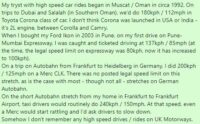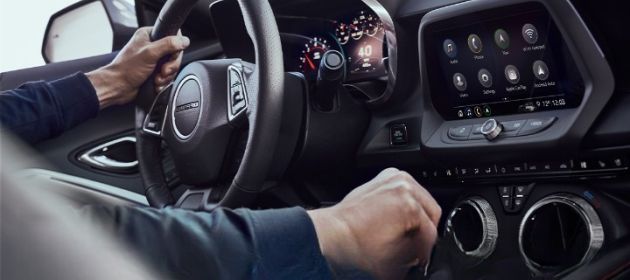In the days following the death by car accident of Cyrus Mistry, the scion of Shapoorjee Palonjee construction group and the largest shareholder in Tata Sons, there’s a lot of public discourse in traditional and digital media about overspeeding, seat belt, air bag, highway signage, and the like.
Let me cite two examples.
ECONOMIC TIMES
Take the following letter to the editor of Economic Times.
The author makes two key points:
- Government should mandate that cars cannot physically go above a speed of 150 kph, being close to the legal speed limit of 120 kph in India.
- In USA, cars cannot physically go beyond 85 mph / 137 kph.
@peaheron: This should be all the evidence we need to lower speed limits. This should be evidence that cars shouldn’t have the horse power to go this fast.
In his LinkedIn Poll, the OP asks the following question:
Should there be a law that allows people to claim compensation from the government for damages and accidents due to unsafe roads?
In this post, I’ll address these points based on personal experience, anecdata and some quick-and-dirty research. Spoiler Alert: This post strays away from sales, marketing, fintech and other mainstay topics of this blog.
Governor Max Speed
All cars have a max speed marked on the speedometer. Parts will probably break down – or even explode – if the car goes above that speed (assuming that it can). On a Tesla, it’s 160 mph / 256 kph.
I have heard of speed governor, a device that physically throttles the RPM of an engine and thereby prevents it from going beyond a certain speed (“governor max speed”).
I also know that, in Germany, where there’s no speed limit on the Autobahn – except in brief stretches where repair work is going on – auto manufacturers have voluntarily installed electronic devices to limit their vehicles to a top speed of 250 kph / 155 mph in order to reduce the political desire to introduce a legal speed limit. (Source: Wikipedia)
Just to be clear, we’re talking about the physical limit that cannot be exceeded due to engineering restraints, not a legal speed limit that can be breached, just at the cost of getting a speeding ticket.
I have seen and read of cars doing well above 85 mph in USA:
- My taxi from Manhattan to JFK airport was doing close to 75 mph on Long Island Expressway and I saw other cars and motorbikes zipping past me at speeds that must have been well above 85 mph.
- In the latest David Baldacci novel titled 6:20 Man, the founder CEO of a white-glove investment bank in NYC whizzes to work in downtown Manhattan from his mansion just outside NYC at 300 mph in his Bugatti (speedometer max speed: 315 mph).
Therefore, I couldn’t believe the aforementioned author’s claim that cars in America were fitted with governors that restricted the speed to 85 mph, and I reached out to my contacts there to do a reality check.
This is what I learned:
 Not one of them has hit the speedometer max speed (phew!).
Not one of them has hit the speedometer max speed (phew!).
All but one of my contacts were only aware of the legal speed limit, which varies from 65 mph (East Coast) to 85 mph (Las Vegas). They hadn’t heard of any devices that restrained the car from going above a certain speed.
 Only one contact – friend, alum and hostel wingmate Sanjay Tamta – was aware of speed governor aka Electronic Speed Limiters (ESL).
Only one contact – friend, alum and hostel wingmate Sanjay Tamta – was aware of speed governor aka Electronic Speed Limiters (ESL).
According to him, they’re installed by the car manufacturer and their max speed setting varies by car make and model. In most cars, the governor max speed is 170 mph whereas, in a BMW M5, which has a speedometer max of 220 mph, the ESL clips the speed at 190 mph. As you can see, both the figures are way above the legal speed limit of 85 mph.
Bloomberg confirms this:
Cars currently sold in the US do have speed governors, but they’re set very high: Some only kick in at 155 mph, far above 85 mph, the highest speed limit anywhere in the country.
Incidentally, this article opens with the account of a car accident on 4 August 2022 in the Windsor Hills neighborhood of Los Angeles. A nurse driving a Mecedes Benz broke a red light at the at the intersection of South La Brea and Slauson avenues and crashed into several other vehicles, which burst into flames. Six people were killed. The nurse was driving at 90 mph, which is way faster than the 35 mph legal speed limit on that stretch.
Disturbing security cam video of the catastrophic crash in Windsor Hills… New details NOW on @ABC7 Eyewitness News at 5pm pic.twitter.com/CQU6y3rHHv
— Chris Cristi (@abc7chriscristi) August 4, 2022
I also stumbled on to Car Speed Limiter by Valley Chevy Dealers, a group of Chevrolet dealerships serving the Phoenix Metro area in Arizona, USA.
The article shills “after market speed limiters”, which restrict a car’s speed to 73 mph. They’re installed by a third-party mechanic i.e. not the auto manufacturer. Leading brands are Highway Guardian and Family Link. It positions ESLs as a way for parents to control their children’s driving and does not state or imply anywhere that they’re mandatory by law in USA.
(Also, by skirting the crucial issue of what happens to the manufacturer’s warranty if a car owner installs a third-party ESL, the article all but tells car owners to consider installing this product only after the warranty period has expired.)
Going by the above, the author’s claim that there’s a mandatory governor max speed of 85 mph in USA comes across as fake news.
Mandate for Speed Governor
 Seat belts, air bags and many other safety measures in the United States came about by regulatory edict, largely credited to the activism of Ralph Nader.
Seat belts, air bags and many other safety measures in the United States came about by regulatory edict, largely credited to the activism of Ralph Nader.
Going by that, the aforementioned author’s advocacy for mandatory installation of devices to stop cars from crossing, say, 95 mph / 150 kph, is not too harebrained because the legal speed limit is not more than ~120 kph in most places.
However, I don’t know of a single government anywhere in the world that has issued a diktat for ESL installation.
I can speculate on many reasons for that:
- Such a mandate would virtually kill sales of high-end cars (and the juicy tax revenues from those sales). Why would somebody pay millions to buy a Bugatti if they can’t drive faster than 85 mph, right? I thought so, too.
- Governments make a lot of money from speeding tickets. #FunFact: In Scandinavian countries, fines for overspeeding are proportional to income of drivers, so an investment banker would pay way more fine than a school teacher for breaking the speed limit by the same extent.
- If the driver is taking a sick family member to the hospital and the car stalls due to an electronic speed limiter mandated by law, then the car manufacturer could refuse to take responsibility for whatever happens because the patient reached the hospital late. Most risk-averse regulators will not take over the liability.
In addition, the aforementioned Bloomberg article offers some more reasons:
- Motorists don’t like loss of freedom.
- Sometimes you genuinely need the extra power to pass slow moving vehicles on the freeway.
Sue Government For Damages
Governments own highways and are responsible for their upkeep. They collect taxes and tolls.
But they still cannot be sued for damages for accidents caused by poor signage and potholes on highways.
That’s because one of the tacit conditions of the issue of Drivers License is that the driver knows the condition of every road in which they will ever drive and adjust their driving accordingly. Memory serves, the EU DL I got in Germany had an explicit condition to this effect.
Accordingly, road condition is deemed to be a given, and the only variables in the liability equation are seat belt, driver negligence, car defect, etc.
Drivers may argue that the above condition is highly unrealistic. However, if they protest too much, DMV / RTO could turn around and tell drivers to pass a driving test before they can drive on any road for the first time. I’m sure drivers will find that condition even less practical.
The Economic Times published a condensed version of my above post on 9 September 2022.


